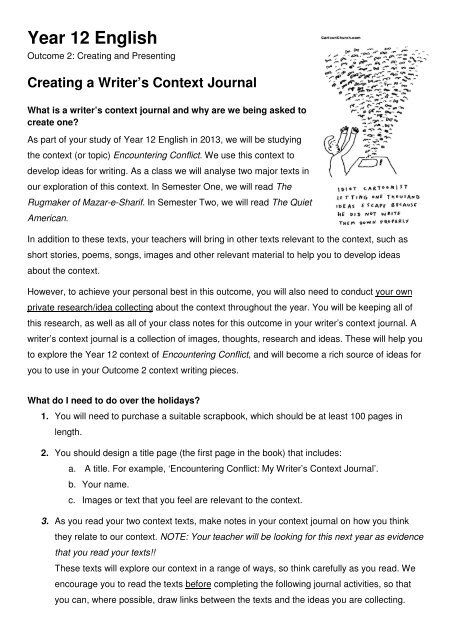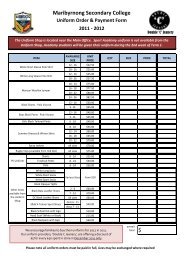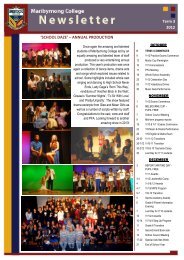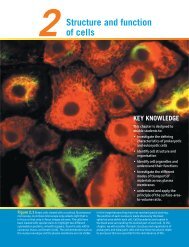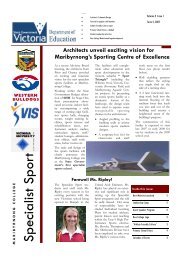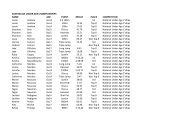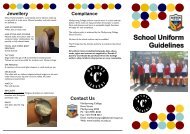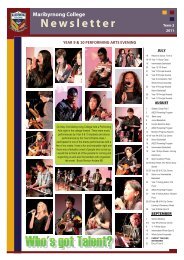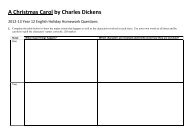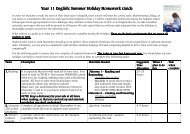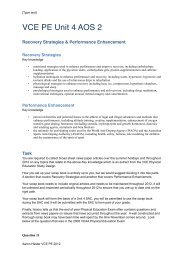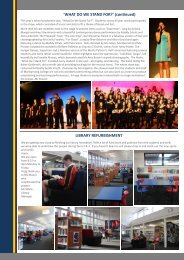Year 12 English
Year 12 English
Year 12 English
Create successful ePaper yourself
Turn your PDF publications into a flip-book with our unique Google optimized e-Paper software.
<strong>Year</strong> <strong>12</strong> <strong>English</strong>Outcome 2: Creating and PresentingCreating a Writer’s Context JournalWhat is a writer’s context journal and why are we being asked tocreate one?As part of your study of <strong>Year</strong> <strong>12</strong> <strong>English</strong> in 2013, we will be studyingthe context (or topic) Encountering Conflict. We use this context todevelop ideas for writing. As a class we will analyse two major texts inour exploration of this context. In Semester One, we will read TheRugmaker of Mazar-e-Sharif. In Semester Two, we will read The QuietAmerican.In addition to these texts, your teachers will bring in other texts relevant to the context, such asshort stories, poems, songs, images and other relevant material to help you to develop ideasabout the context.However, to achieve your personal best in this outcome, you will also need to conduct your ownprivate research/idea collecting about the context throughout the year. You will be keeping all ofthis research, as well as all of your class notes for this outcome in your writer’s context journal. Awriter’s context journal is a collection of images, thoughts, research and ideas. These will help youto explore the <strong>Year</strong> <strong>12</strong> context of Encountering Conflict, and will become a rich source of ideas foryou to use in your Outcome 2 context writing pieces.What do I need to do over the holidays?1. You will need to purchase a suitable scrapbook, which should be at least 100 pages inlength.2. You should design a title page (the first page in the book) that includes:a. A title. For example, ‘Encountering Conflict: My Writer’s Context Journal’.b. Your name.c. Images or text that you feel are relevant to the context.3. As you read your two context texts, make notes in your context journal on how you thinkthey relate to our context. NOTE: Your teacher will be looking for this next year as evidencethat you read your texts!!These texts will explore our context in a range of ways, so think carefully as you read. Weencourage you to read the texts before completing the following journal activities, so thatyou can, where possible, draw links between the texts and the ideas you are collecting.
4. You should collect at least 25 images relevant to the context. These might be photographs,cartoons or advertisements, for example. They need to be neatly pasted into your writer’scontext journal, and should be annotated. (See the section on this handout aboutannotation if unsure about this.)5. You should find 3 songs that you feel are relevant to our context. Each song should explorethe context in a different way. Paste a copy of the lyrics for each song into your journal andannotate them.6. Collect 6 newspaper articles that are relevant to our context. Three should deal withAustralian stories/ideas/issues. The other three should deal with internationalstories/ideas/issues. Each article must be pasted into your journal and should bethoughtfully annotated. (Note: only two articles are allowed to come from the Herald Sun.The others must come from other national or international newspapers.)7. Watch two films that explore ideas relevant to our context. Write the name of the film in thecentre of a page in your context journal, and brainstorm around this all the ways in whichthe film explores ideas associated with Encountering Conflict.8. You may include anything else of your choice in your writer’s journal that is relevant to ourcontext. Other things that you may like to include are poems, short stories, web-links, blogs,journal articles, headlines, film posters or famous quotes - really anything you like! You canbe extremely creative in putting your writer’s context journal together. Whatever you chooseto include, it is important to annotate your entries. Be thoughtful and imaginative!What does it mean to annotate my entries???Rather than just pasting things into your journal, we want you to think about how they relateto our context. This is why we will ask you to annotate them.To annotate means to “add explanatory notes.” In other words, there are written commentsextending from the entry, where you will make notes about your thoughts (be it photograph, songor famous quote).In your written annotations, think especially about how the entry links to the main idea beingexplored (in our case, this is our context Encountering Conflict.) You may also like to think abouthow it could relate to the context ideas explored in our two texts.
Assessment of your Context Writer’s JournalThis context journal is a compulsory course requirement. We will be using it throughout the year,and it will count towards “not up to date” status’ in the redemption reporting cycles. Forewarned isforearmed!Your teacher will collect your journal on the first day of term in 2013. You will be given a mark forthe holiday component of the holiday journal work based on the following criteria.Context Writer’s Journal: Success Criteria for Holiday Journal WorkVH - 5 H - 4 M - 3 L - 2 VL - 1 NS - 0Context journal provides written notes andevidence to suggest that context texts (TheRugmaker of Mazar-e-sharif and The QuietAmerican) have been read and thoughtfullyconsidered. Annotations are accurate,detailed and insightful.All context journal tasks have beencompleted. Detailed annotations areconsistently included, are thoughtful andrelevant to the context.The context journal is neat, creative andthoughtfully presented./15Comments:


